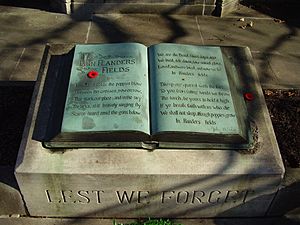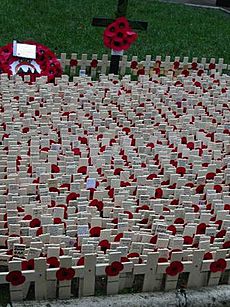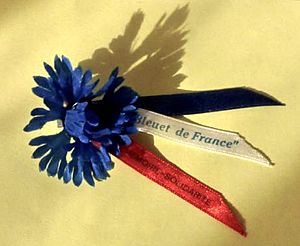Remembrance Day facts for kids
Quick facts for kids Remembrance Day |
|
|---|---|
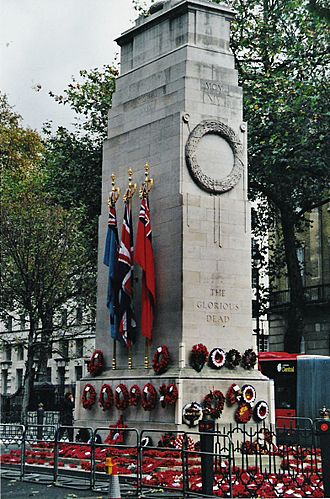
The Cenotaph in London on Remembrance Day 2004
|
|
| Official name | Remembrance Day |
| Also called | Poppy Day |
| Observed by | Commonwealth of Nations |
| Type | International |
| Significance | Commemorates Commonwealth war dead |
| Observances | Parades, moments of silence |
| Date | November 11 |
| Frequency | Annually |
| Related to | Armistice Day, Veterans Day, Memorial Day, Anzac Day |
Remembrance Day is a special day to remember and honor members of the armed forces who have died while serving their country. It is also known as Armistice Day or Poppy Day. People often wear a remembrance poppy on this day.
This memorial day is observed in many countries that are part of the Commonwealth of Nations. It began after World War I. In many places, Remembrance Day is held on November 11. This date marks the end of the fighting in World War I. The war officially stopped "at the 11th hour of the 11th day of the 11th month" in 1918. This was when the armistice (a peace agreement) was signed. World War I officially ended later, on June 28, 1919, with the signing of the Treaty of Versailles.
The first official Armistice Day was held on November 11, 1919, at Buckingham Palace in London. During World War II, many countries changed the name and purpose of the holiday. Commonwealth countries chose Remembrance Day. The United States chose Veterans Day to honor all veterans, both living and dead.
Contents
How is Remembrance Day Observed?
In many Commonwealth countries, people observe a one- or two-minute silence at 11:00 am on November 11. This is because it marks the exact time the armistice (peace agreement) began.
Remembrance services often include special songs, a period of silence, and then the sounding of "Reveille" (a bugle call). People also lay wreaths (circles of flowers or leaves) to honor those who died. There are also blessings and national anthems sung.
Remembrance Day in Australia
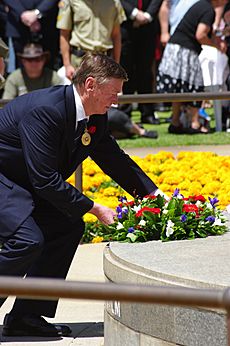
In Australia, Remembrance Day is always on November 11. It is not a public holiday. It's a time for people to show respect for soldiers who died in battle. Some schools have a two-minute silence at 11:00 am. In big cities like Melbourne, buglers from the Australian Defence Force sometimes play the "Last Post" at street corners. Many people stop and observe a moment of silence.
Remembrance Day in Canada
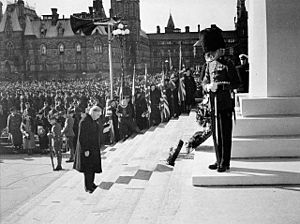
In Canada, Remembrance Day (Jour du Souvenir) is a public holiday in most parts of the country. However, Manitoba, Ontario, and Quebec do not treat it as an official holiday.
The main national ceremonies are held at the National War Memorial in Ottawa. The event starts with the ringing of the carillon bells in the Peace Tower. People lay wreaths at the memorial. Since 2000, people also place poppies on the Canadian Tomb of the Unknown Soldier. Similar ceremonies happen in other cities across Canada.
Canada also has other remembrance days. National Aboriginal Veterans Day on November 8 honors Aboriginal soldiers. Merchant Navy Remembrance Day on September 3 recognizes Canadian merchant mariners.
Remembrance Day in the United Kingdom
In the UK, wreath-laying ceremonies happen at war memorials at 11:00 am on November 11. Two minutes of silence are observed. This silence is even broadcast on TV. Many workplaces also ask staff to observe the silence. In big towns, a field artillery gun might be fired to mark the start and end of the silence.
Remembrance Sunday

The main observance in the UK is Remembrance Sunday. This is held on the Sunday closest to November 11. There is a big National Service of Remembrance in London. Other services and ceremonies take place around the country. Churches often include a minute or two of silence in their services.
Northern Ireland
Remembrance Day is observed in Northern Ireland just like in the rest of the UK. However, the Republic of Ireland has its own National Day of Commemoration in July. This day remembers all Irish people who have died in war.
Other Commonwealth Countries
- In Barbados, Remembrance Day is on November 11, but the main parade and events are on Remembrance Sunday. It honors Barbadian soldiers from World War I and World War II.
- Belize observes Remembrance Day on November 11, but it is not a public holiday.
- Bermuda still sees Remembrance Day as very important. Bermuda sent the first colonial volunteer unit to the Western Front in 1915.
- In India, the day is usually marked by tributes at army stations. There are memorial services in some churches and at war cemeteries like Kohima and Imphal.
- In Kenya, the Kenya Armed Forces Old Comrades Association (KAFOCA) and the government recognize Remembrance Day.
- New Zealand's main day of remembrance is ANZAC Day on April 25. The reason for this is that the paper poppies for Armistice Day arrived too late in 1921. So, they were given out on ANZAC Day instead, and that date stuck as "Poppy Day" in New Zealand.
- Like Barbados, St. Lucia holds its ceremonial events on Remembrance Sunday, not on November 11 itself.
- In South Africa, Remembrance Day is not a public holiday. Ceremonies are usually held on the nearest Sunday. The "Last Post" is played, followed by a two-minute silence.
Similar Observances Around the World
Some countries outside the Commonwealth also have similar days of remembrance.
France and Belgium
Remembrance Day (November 11) is a national holiday in France and Belgium. It is a very important military celebration in France. The French lost many soldiers in World War I, which they called the "Great Patriotic War." In France, a blue cornflower (called Bleuet de France) is used as a symbol instead of the poppy.
Germany
Germany has a national day of mourning called Volkstrauertag. It is observed two Sundays before the first Sunday of Advent. The anniversary of the Armistice itself is not observed in Germany.
Hong Kong

Hong Kong is no longer part of the Commonwealth of Nations since 1997. So, Remembrance Day is not a public holiday there. However, Remembrance Sunday is still observed.
United States
Veterans Day is observed in the United States on November 11. It is a federal and state holiday. It was renamed in 1954 after the Korean War to honor all veterans, both living and dead. Veterans Day includes memorial ceremonies, salutes at military cemeteries, and parades.
In the United States, Memorial Day is celebrated on the last Monday of May. This day is specifically for remembering fallen soldiers from all wars.
Interesting Facts about Remembrance Day
- The poppy is a symbol for Remembrance Day. It represents the blood spilled in World War I.
- The poppy tradition started because these red flowers were seen growing over the graves of soldiers.
- Poppies are worn from the last Friday in October until November 11. Money raised from the “Poppy Campaign” helps military veterans who need support.
- The bugle is often played at military funerals and on Remembrance Day. It symbolizes that soldiers can rest in peace. In war, the bugle was used to tell soldiers it was time to return to their barracks and sleep.
- Gun salutes are used in some Remembrance Day ceremonies around the world.
- Some other names for World War I include The War to End All Wars, The War of the Nations, and The Great War.
See also
 In Spanish: Día del Recuerdo para niños
In Spanish: Día del Recuerdo para niños
Images for kids
-
The Royal Family always attend the Poppy Day
-
Remembrance Day, Kings Park 2020


